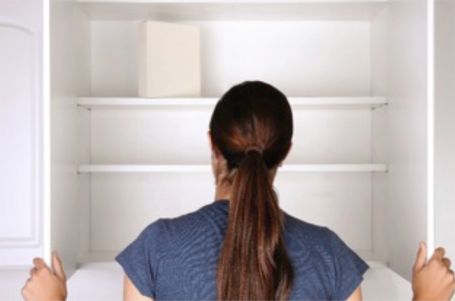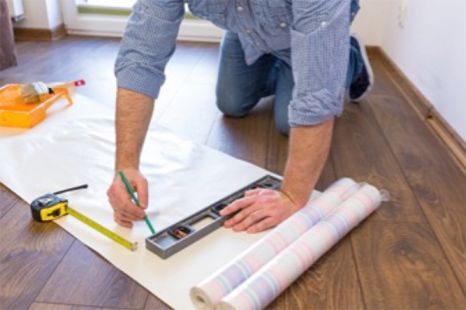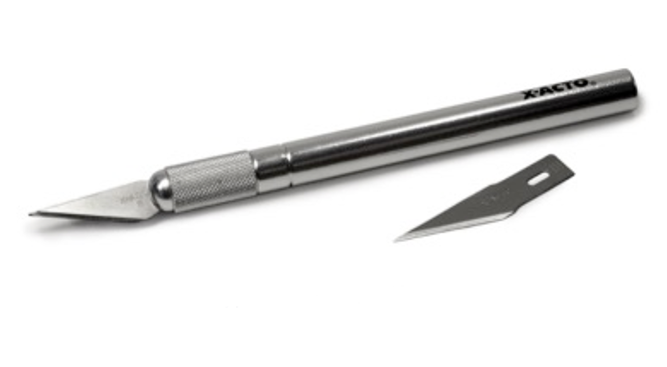How to Perfectly Wallpaper the Inside of your Cabinets
Need a way to make your kitchen cabinets stand apart from the rest? Not a problem! By simply layering the interior of your cabinets with wallpaper, you’ll be able to brighten up their basic look with a refreshing touch of color.
This quick cabinet modification pops cheerfully out at you whenever you open your cabinet doors, and blends perfectly with windowed cabinet fronts that naturally show off their stylized interiors.
It’s also readily reversible, making it a rental friendly way to transform drab cabinet interiors into stylized storage spaces worthy of showcasing. Plus, even if upset landlords aren’t a concern, the low cost of supplies and the dramatic change wallpaper gives to a cabinet’s appearance is reason enough for any household to consider wallpapering their cabinet interiors.
Materials
- Wallpaper
- Painter’s Tape
- Sponge
- X-ACTO Knife
- Scissors
- Measuring Tape
How to Wallpaper a Cabinet Interior
Once you have your materials together, the task of actually wallpapering the inside of your cabinets is a pretty short process. Just follow the steps below, and you’ll be finished in no time!
1. Empty Out your Cabinets
Before you get to wallpapering, you need to empty your cabinet to prepare for installation first.
If possible, remove the shelves from your cabinet box first. Doing so will simplify the wallpapering process, and make this project much easier on you. If you can’t remove your cabinet’s shelves, you’ll need to carefully wallpaper between them.
Clean the interior of your cabinet, taking care to wipe down each area that the wallpaper will touch so that it can stick securely to those surfaces.
2. Measure Cabinets and Cut Wallpaper
Accurately measure the inside of your cabinet, and use these dimensions to cut pieces of wallpaper to size with your scissors for each surface it needs to cover.
When cutting your wallpaper, it’s a good idea to leave an extra couple inches more than you need on each piece. It’ll be a lot simpler to cut away excess wallpaper from your cabinet once it’s dried than it is to cut out and install perfectly sized pieces.
Remember to account for the pattern of your wallpaper as you go. Cut your pieces so that you can align the wallpaper’s pattern to your liking as you install it, and plan for any spots where the paper will need to overlap.
3. Wet and Ready your Wallpaper
After you have your pieces of wallpaper cut, it’s time to wet them so they can adhere to your cabinet walls.
- Fill a tub with a few inches room temperature water, or simply use a sink if your pieces of wallpaper are small enough. Fold your pieces of wallpaper so the printed end is on the inside, and hold them under water for around 20 seconds.
- After being submerged for long enough, remove the pieces and lay them down on their printed side so the back-adhesive side is facing up. Be careful that the adhesive side of your paper doesn’t come into contact with anything other than itself from this point, or it will stick.
- Lastly, let the wetted wallpaper sit for a couple minutes before moving onto installation.
4. Wallpaper your Cabinet
Once your wallpaper is wetted and ready to stick, you can begin now layering it inside your cabinet.
Take your first piece of wallpaper and start at one of the top corners of your cabinet’s wall. Press the wallpaper into place and it will begin to stick, though you will still need to reinforce it with painter’s tape to keep it there. Tape from the ceiling of your cabinet’s interior and over the fresh wallpaper to hold everything securely in position.
With the top of your wallpaper taped, grab your sponge and dampen it. Afterward, use it to press the remaining areas of your wallpaper piece to its cabinet wall. Move slowly along the wallpaper from top to bottom and make sure you eliminate any air pockets between it and your cabinet wall as you go.
Repeat this step for each piece of wallpaper you need to place, taking care that you align the wallpaper’s pattern accurately with each installed piece as you add the next. Once you’ve finished installation, don’t worry about any excess wallpaper just yet, and let everything dry completely before moving onto the last step.
5. Cut Away Excess Paper
To finish off this project and polish up the look of your cabinet, all that’s left to do is cut away any remaining wallpaper that’s overflowed from your wall.
Remove the painter’s tape from the top of your wallpaper pieces. Now dry, your wallpaper should be strongly adhered to your cabinet’s surfaces, and no longer needs this taped support.
Take your X-ACTO knife and neatly cut into the corners of your cabinet to slice away any leftover paper. As you remove the excess paper, some residue of glue will likely remain in its place. Simply wipe it away with your dampened sponge, and it should come right out.
With these finishing touches, your cabinet’s wallpapering will be complete. Continue to repeat these 5 steps for each cabinet that you’d like to wallpaper, and enjoy the revitalized appearance of your kitchen cabinetry!
 MADE IN THE USA
MADE IN THE USA






